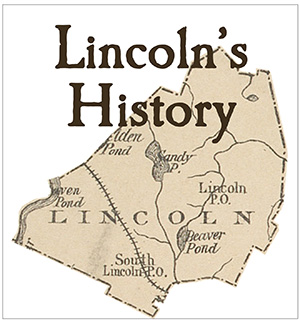By Sara Mattes
 (Editor’s note: The Lincoln Historical Society used this raging controversy as its theme for this year’s July 4 parade float — see the first picture in this photo gallery.)
(Editor’s note: The Lincoln Historical Society used this raging controversy as its theme for this year’s July 4 parade float — see the first picture in this photo gallery.)
In Lincoln’s earliest history, the road was known simply as Middle County Road. Lincoln lore has it that the name “Trapelo Road” derived from “traps below,” referring to the beaver traps that were set along the Beaver Brook in northeast Waltham. But that is probably myth, and a dive into archives offers an alternate explanation.
According to noted Waltham historian Edmund Sanderson, author of Waltham as a Precinct of Watertown and as a Town, the road from Beaver Brook to the Lincoln border was known for its steep hills. It was the custom to have horses stationed at the foot of such hills that could be temporarily hooked up to assist wagons with heavy loads. The word “trapelo” in Italian means “to drag by hooks or by extra horses,” so this practice in Italy is called “going trapelo.”
So, while some in Lincoln pronounce it “TRAPelo,” in light of the Italian derivation of the word, the proper pronunciation would be “TraPELo.” All the other towns through which Trapelo runs pronounce it “TraPELo.” Lincoln remains the outlier.
(This will be the first of several pieces on the development of Lincoln’s road system. We are very indebted to Kerry Glass’s important work on the evolution of Lincoln roads from its beginnings, using original deeds and maps. This work, “Tracing the History of Lincoln Ways,” will soon be available on line through Lincoln Archives and the Lincoln Historical Society.)
“Lincoln’s History” is an occasional column by members of the Lincoln Historical Society.
I like that Lincoln is an outlier. I lived in Lincoln for 56 years. I never heard TraPELo in the early years; it is a new comer.
A very Lincoln story. Thank you!
I’m with Katherine. Growing up here on Trapelo Road, it’s always been TRAPelo Road, despite how our neighbors to the east pronounced it.
In the spirit of holding on to a piece of local Lincoln color, I’m going to hold on to Lincoln’s historical pronunciation.
Cheers,
TD
When we built our house in Lincoln 30 years ago, I was told very firmly by the folks in the Town Offices that our new address was pronounced TRAP-elo by those who lived in Lincoln. I see no reason to change it just because the other towns pronounce it differently. That said, I use the two pronunciations interchangeably if I think it makes it easier on someone with whom I’m talking.
This is an interesting bit of history with respect to the alternative pronunciations of Trapelo. Even though I have driven the length of Trapelo many times, I was motivated to drive it this morning to experience the rolling terrain through new eyes. Trapelo Road, from the Flower Pot in Lincoln to its end at Belmont St. is approximately 7.9 miles long; only one-quarter of the length of TRAP-elow is in Lincoln. The route is one of rolling hills and dales. The lowest elevation, 70 feet, is at the intersection of Tra-PELLo and Beaver Creek Reservation. The elevation at the Flower Pot is 200 feet. There are a series of hills and dales in between that modulate the ascent from 70’ to 200’. The highest hill, cresting at 300 feet, is in Waltham. Several questions come to mind that include: When was Middle County Road renamed Trapelo? Was the use of “trapelo” as defined common in New England? Why adapt an Italian term? Beaver Creek Reservation is 6.3 miles from the Flower Part. Why would Lincoln residents refer to “traps below” for traps so far from Lincoln? Six miles was a long way to travel back in the day. Were there traps at the much closer Hobbs Creek? If a myth (which seems probable), when and why did it start?
What a delightful mystery that will likely never be resolved. All-in-all a fun bit of local color and another reason why Lincoln is unique.
P.S. Here’s the pronunciation in Italian: https://educalingo.com/en/dic-it/trapelo
Sara – great piece of history – thank you. As a Newton native, we knew it as TraPELo – so I wholeheartedly agree with your findings! ; )